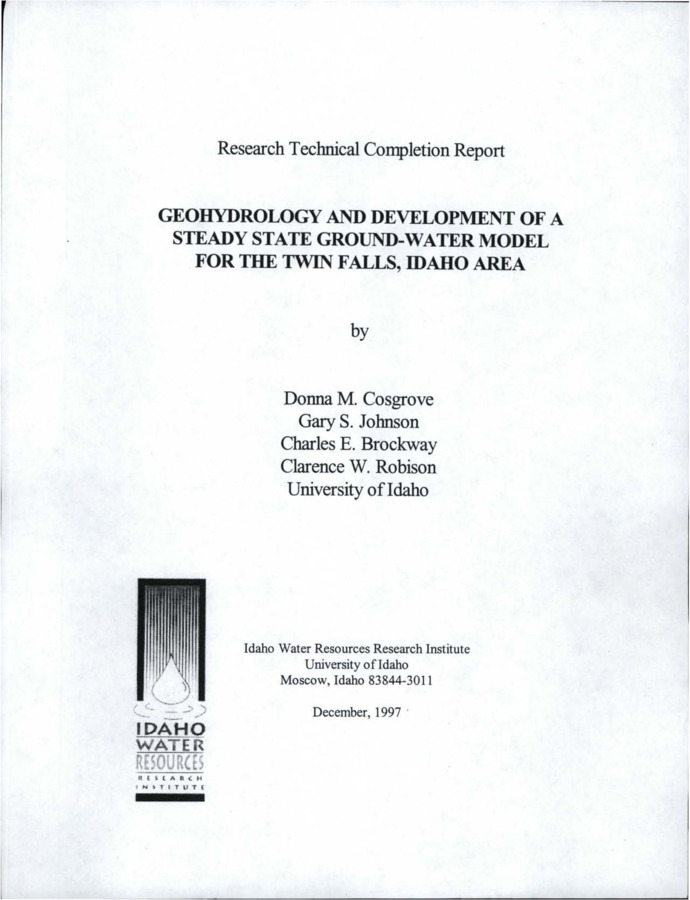PDF
Geohydrology and development of a steady state groundwater model for the Twin Falls, Idaho area. Research technical completion report Item Info
- Title:
- Geohydrology and development of a steady state groundwater model for the Twin Falls, Idaho area. Research technical completion report
- Authors:
- Cosgrove, Donna M.; Johnson, Gary S.; Brockway, Charles E.; Robison, Clarence W.
- Date Created (ISO Standard):
- 1997-12
- Description:
- Rapid growth in the city of Twin Falls, Idaho has stressed the current water supply system. In an effort to gain an understanding of the area geohydrology, the city contracted with the University of Idaho Water Resources Research Institute to develop a numerical groundwater flow model for the aquifer underlying the city of Twin Falls. The steady state groundwater flow model was developed based on recharge and discharge data from the last twenty years. The primary source of recharge to the area is irrigation by the Twin falls Canal Company. Evapotranspiration and unmeasured springs to the Snake River and other surface streams are important sources of discharge from the aquifer. A water budget for the basin was developed using precipitation, surface flow and crop distribution data. Evapotranspiration was calculated using average crop distributions and reference evapotranspiration values. Applied irrigation water was calculated from diversions, measured irrigation returns and land use data. Underflow from tributary basins was estimated or obtained from the literature. The steady state numerical groundwater flow model was calibrated to water level measurements taken from December 1995 to December 1996. The network of 113 wells was measured five times in that thirteen month period. The model parameters which were calibrated were model hydraulic conductivity and spring conductance. Comparison of simulated water levels with measured water levels resulted in a mean absolute error of 17.5 ft. and a root mean square of 24.4 ft., with eighty-one percent of simulated water levels being within 30 feet of measured water levels. As stresses on the aquifer grow, water levels are dropping, causing concern over increased pump lifts and reduced spring flows. The calibrated steady state groundwater model provides the city with a management tool for evaluating changes in water and land use, as well as potential water development and recharge scenarios.
- Subjects:
- Geohydrology Geology Aquifers Groundwater flow Groundwater recharge Water budget Irrigation Municipal water Computer models Computer simulation
- Location:
- Twin Falls; Snake River Basin; Southern Idaho
- Latitude:
- 42.56
- Longitude:
- -114.46
- Collection:
- Boise Basin
- IWRRI number:
- 199703
- Rights:
- In copyright, educational use permitted. Educational use includes non-commercial reproduction of text and images in materials for teaching and research purposes. For other contexts beyond fair use, including digital reproduction, please contact the University of Idaho Library Special Collections and Archives Department at libspec@uidaho.edu. The University of Idaho Library is not liable for any violations of the law by users.
- Publisher:
- Idaho Water Resources Research Institute; University of Idaho
- Contributing Institution:
- University of Idaho
- Type:
- Text
- Format:
- application/pdf
- Cataloger:
- KIT
- Date Digitized:
- 2017-09-26
Source
- Preferred Citation:
- "Geohydrology and development of a steady state groundwater model for the Twin Falls, Idaho area. Research technical completion report", Idaho Waters Digital Library, University of Idaho Library Digital Collections, https://www.lib.uidaho.edu/digital/iwdl/items/iwdl-199703.html
Rights
- Rights:
- In copyright, educational use permitted. Educational use includes non-commercial reproduction of text and images in materials for teaching and research purposes. For other contexts beyond fair use, including digital reproduction, please contact the University of Idaho Library Special Collections and Archives Department at libspec@uidaho.edu. The University of Idaho Library is not liable for any violations of the law by users.
- Standardized Rights:
- http://rightsstatements.org/vocab/InC-EDU/1.0/

